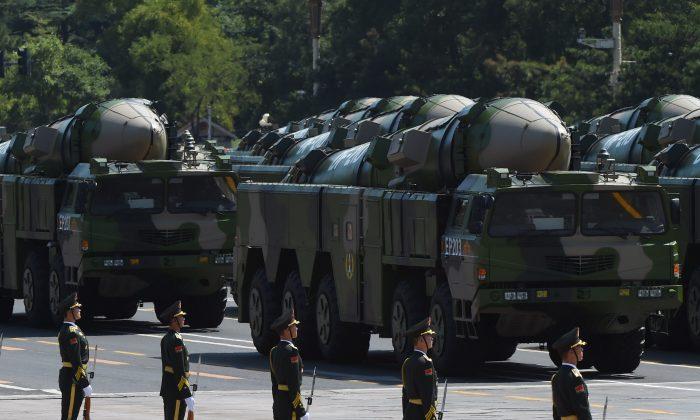Commentary
China’s testing of low-yield nuclear weapons is consistent with its strategy to intensify strategic U.S. competition in the “gray zone” just below the threshold of armed conflict.
Low-yield nuclear warheads of less than 5 kilotons (KT) are the perfect weapon to blur the distinction between nuclear and conventional warfare. Fielding such a low collateral damage system would give China the capability to back the United States into a corner, where full-scale thermonuclear war or capitulation would be a U.S. president’s only options.
Nuclear testing allows the Chinese regime to improve its atomic warheads, but it could also lead to a new generation of earth-penetrating “low-yield” nuclear weapons that would “limit collateral damage” from radioactive fallout caused by dirt thrown into the air from a blast.
The 2017 U.S. National Security Strategy warned that the United States was entering a period of intensifying strategic rivalry with China. In addition to traditional adversarial efforts to coerce, acquire influence within, or destabilize key countries and regions, China would expand the spectrum of gray zone competition to psychological warfare, subversion of political systems, and covert paramilitary and information operations.
To respond to gray zone provocations, the RAND Corp. suggests the United States divide its responses into three categories: aggressive actions that the United States should seek to deter; persistent actions it must live with but compete against; and moderate actions in the middle that the United States should actively seek to discourage over time.
Another example of China competing in the gray zone is the Intermediate-Range Nuclear Forces (INF) Treaty that was signed by the United States and Russia in 1987 to eliminate all ground-based missiles with ranges between 310 and 3,420 miles. As a non-signatory, China has legally fielded a huge arsenal, of which 90 percent of land-based anti-access/area denial missiles would violate the treaty.
This arsenal includes the satellite-guided DF-21D “carrier killer” that has a target range of 933 miles and a conventional high-explosive warhead that can sink U.S. warships in the eastern Pacific, and target structures at U.S. bases and those of its allies in Taiwan, Japan, and South Korea.
The United States has been forced to live with “persistent” increases in China’s conventional missiles. The DF-21D and the new D-17 hypersonic missile are now capable of being armed with low-yield nuclear warheads to attack underground bunkers and 500-kiloton nuclear warheads to wipe out a fleet or city.
Consistent with seeking to “deter” the proliferation of such destabilizing weapons, the Trump administration withdrew from the INF Treaty on Aug. 2, 2019, and announced on Feb. 4 the deployment of the W76-2 “low-yield” nuclear warhead on some American ballistic missile submarines. Unlike aircraft carriers that are easy targets for China’s intermediate-range missiles, U.S. submarines can penetrate China’s defenses.
The U.S. State Department has also alleged that China violated the 1984 Biological and Toxin Weapons Convention by developing dual-use civilian and military applications.
The Chinese regime is also taking advantage of the crisis caused by the COVID-19 pandemic. It conducted a series of gray zone provocations, following the withdrawal of the USS Theodore Roosevelt aircraft carrier task force from the East China Sea on March 24, and the simultaneous lockdown and quarantine of the USS Ronald Reagan aircraft carrier at its pier in Yokosuka, Japan.
As Beijing continues its illegal effort to claim territorial rights to 80 percent of the South and East China seas, Chinese fighter jets for the first time in more than a decade violated Taiwan airspace by crossing the “median line” of the 110-mile wide Taiwan Strait on March 31.
Ten days later, an attack formation consisting of “several” Chinese J-11 jet fighters, H-6 bombers, KJ-500 command and surveillance aircraft violated Taiwan’s airspace twice.
Without an aircraft carrier in the Eastern Pacific, the Trump administration sought to compete with such a “persistent” threat by increasing EP-3E ARIES II reconnaissance flights and conducting B-52 Stratofortress bomber sorties around Taiwan.
When China sent its Liaoning aircraft carrier near the Japanese islands of Okinawa and Miyako over the weekend, the United States on April 13 sought to “deter” such an aggressive act. The U.S. military conducted an “elephant walk” at Guam’s Andersen Air Force Base by lining up five B-52 Stratofortress strategic bombers; six KC-135 Stratotanker aerial refuelers; an MH-60S Knighthawk helicopter; and two unmanned aerial vehicles: an Air Force RQ-4 Global Hawk and a Navy MQ-4C Triton.
Chriss Street is an expert in macroeconomics, technology, and national security. He has served as CEO of several companies and is an active writer with more than 1,500 publications. He also regularly provides strategy lectures to graduate students at top Southern California universities.
Views expressed in this article are opinions of the author and do not necessarily reflect the views of The Epoch Times.





